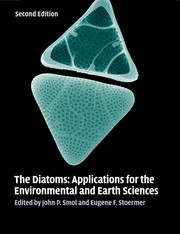Book contents
- Frontmatter
- Contents
- List of contributors
- Preface
- Part I Introduction
- Part II Diatoms as indicators of environmental change in flowing waters and lakes
- Part III Diatoms as indicators in Arctic, Antarctic, and alpine lacustrine environments
- Part IV Diatoms as indicators in marine and estuarine environments
- Part V Other applications
- Part VI Conclusions
- Glossary, acronyms, and abbreviations
- Index
Preface
Published online by Cambridge University Press: 05 June 2012
- Frontmatter
- Contents
- List of contributors
- Preface
- Part I Introduction
- Part II Diatoms as indicators of environmental change in flowing waters and lakes
- Part III Diatoms as indicators in Arctic, Antarctic, and alpine lacustrine environments
- Part IV Diatoms as indicators in marine and estuarine environments
- Part V Other applications
- Part VI Conclusions
- Glossary, acronyms, and abbreviations
- Index
Summary
“If there is magic on this planet, it is contained in water.”
(Loran Eiseley, The Immense Journey, 1957)Diatoms are being used increasingly in a wide range of applications, and the number of diatomists and their publications continues to increase rapidly. Although several books have dealt with various aspects of diatom biology, ecology, and taxonomy, the first edition of this volume, published over a decade ago, was the first to summarize the many applications and uses of diatoms. However, many new and exciting papers have been published in the intervening years. This, coupled with the fact that research on environmental and earth science applications of diatoms has continued at a frenetic pace, prompted us to undertake a major revision of our first edition.
Our overall goal was to collate a series of review chapters that would cover most of the key applications and uses of diatoms in the environmental and earth sciences. Due to space limitations, we could not include all types of applications, but we hope to have covered the main ones. Moreover, many of the chapters could easily have been double in size, and in fact several chapters could have been expanded to the size of books. Nonetheless, we hope material has been reviewed in sufficient breadth and detail to make this a valuable reference book for a wide spectrum of scientists, managers, and other users.
- Type
- Chapter
- Information
- The DiatomsApplications for the Environmental and Earth Sciences, pp. xvii - xviiiPublisher: Cambridge University PressPrint publication year: 2010

